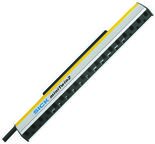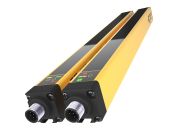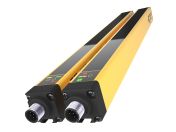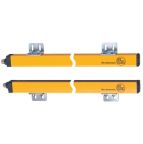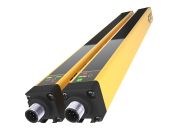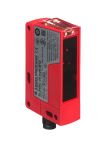Light Curtains
Safety light curtains are also known as safety light barriers or safety light screens. These photoelectric devices are used to detect people present in the vicinity of moving machines.
Light curtains can be used as an alternative to mechanical barriers and other forms of traditional machine guarding. A set of light curtains contains a transmitter head and a receiver head. A transmitter generates an infra-red light beam between the two heads which acts as a detection zone. Any movement detected within the detection zone initiates the machine stopping procedure and automatically disconnects all hazardous machinery.
To reactivate the machinery, an operator has to press the reset button that is positioned outside of the danger area. Some models are equipped with an auto-reset option that automatically starts machinery once the detection zone is free of obstacles.
Light curtains provide an unparalleled level of safety with their incredibly fast response times, surpassing any other barrier type. These advanced safety devices safeguard personnel in hazardous machine environments.
Light Curtain Types
Light curtains are essential safety devices. They come in various configurations to address different safety needs. Understanding these types is crucial for selecting the right light curtain sensor.
Type 2 Light Curtains
Type 2 light curtains offer a basic level of protection suitable for applications with lower risk hazards. These curtains have a lower resolution and sensor capability compared to Type 4 curtains, making them a cost-effective solution for applications with basic safety requirements.
Type 4 Light Curtains
Type 4 light curtains provide the highest level of safety and are designed for applications with higher risk machine hazards, such as robotic workcells and areas requiring point of operation guarding.
Type 4 curtains incorporate redundant circuitry and self-checking mechanisms to ensure reliable operation and minimise the possibility of failure.
Finger Detection Light Curtains
These specialised light curtains are designed to detect even the smallest intrusions, such as fingers, in hazardous areas. They offer a high level of protection for applications where precise finger protection is crucial, such as presses, stamping machines, and assembly lines.
Long-Range Light Curtains
Long-range light curtains, also referred to as light guards, provide protection over greater distances. They are often used for perimeter guarding and access control in large industrial areas, such as protecting personnel from approaching dangerous machinery.
Long-range light curtains have an extended sensor range and a robust design suitable for outdoor or harsh environments. They are often combined with warning systems to alert personnel before they enter a hazardous area.
Key Features of Light Curtain Sensor
Light curtain sensors offer a range of features that ensure reliable protection and adapt to various applications:
Multiple Beam Configuration
Light curtains use an array of infrared beams to create a sensing field. The number and spacing of these beams determine the resolution and sensitivity of the curtain. A higher beam density allows for the detection of smaller objects, enhancing safety in applications where precise object detection is crucial.
Fast Response Time
Light curtains boast incredibly fast response times, typically in the millisecond range. This ensures that the safety system reacts quickly to any intrusion.
Self-Checking Mechanisms
To ensure the highest level of safety, light curtains incorporate self-checking mechanisms. These mechanisms continuously monitor the integrity of the sensor and its circuitry, detecting any faults or malfunctions that could compromise safety.
Blanking and Muting Functions
Light curtains offer advanced features like blanking and muting to enhance flexibility and prevent unnecessary stoppages. Blanking allows specific beams to be ignored, accommodating the presence of fixtures or workpieces within the sensing field.
Muting temporarily disables the light curtain's safety function, enabling the safe passage of materials or equipment through the protected area.
Cascading Capability
For applications in Australia requiring extended safety coverage, multiple light curtains can be cascaded together to create a larger protective field. This is particularly useful for safeguarding long conveyor lines or large access points.
Benefits of Using Light Curtain Safety Devices
Light curtains offer significant advantages over traditional machine guarding methods, making them a preferred choice for enhancing workplace safety:
- Enhanced Safety: Light curtains provide a higher level of safetycompared to physical barriers. This is particularly crucial in high-speed machinery environments where traditional guards may not provide adequate protection.
- Improved Productivity: Unlike physical barriers that can hinder access and impede workflow, light curtains allow for easier access to machinery while maintaining safety. This improves productivity by reducing downtime associated with opening and closing gates or fences.
- Increased Flexibility: Light curtains offer greater flexibility compared to fixed guards. They can be easily adjusted or reconfigured to accommodate changes in production processes or machinery layouts.
- Reduced Downtime: Light curtains contribute to reduced downtime in several ways. Their self-checking mechanisms ensure reliable operation and minimise unexpected failures. Additionally, features like muting and blanking allow for the safe passage of materials or equipment without completely disabling the safety system.
- Space Optimisation: Light curtains have a smaller footprint compared to bulky physical guards, making them ideal for applications where space is limited.
Industrial Applications of Light Curtains
Light curtains are a way of guarding employees from dangerous machines. The design of the safety light curtain offers more flexibility and simplifies machine set up, maintenance and repair than other solid traditional guarding systems such as mechanical barriers and sliding gates.
They can be found in various applications including:
Packaging Machines
In the packaging industry, light guards safeguard workers from fast-moving machinery such as conveyors, sealing machines, and robotic packaging systems.
Process Machinery
Process industries, such as chemical processing and food production, utilise light curtains to protect workers from potentially dangerous equipment like mixers, reactors, and filling lines.
Automated Warehouses
Automated warehouses rely on light curtains to protect personnel working alongside automated guided vehicles (AGVs) and robotic systems. The curtains define safety zones around these automated systems, ensuring that workers are not in harm's way during material handling and transportation tasks.
Textile Machinery
Textile manufacturing involves high-speed machinery with potential entanglement hazards. Light curtains are used to protect workers from rotating parts, cutting blades, and other dangerous elements.
Electronic Component Assembly Lines
Electronic component assembly lines often involve intricate and delicate processes. Light curtains are used to protect workers from robotic arms, soldering equipment, and other potentially hazardous elements on these assembly lines.
Mechanical and Hydraulic Power Presses
Power presses pose significant risks to operators due to their powerful stamping and forming actions. Light curtains provide a crucial safety barrier, protecting workers from severe crushing injuries.
Difference between Safety Light Barrier and Simple Light Barrier
While the terms "safety light barrier" and "simple light barrier" might seem interchangeable, there are key distinctions between the two:
- Safety Light Barriers: These are specifically designed to meet stringent safety standards and regulations. Safety light curtains incorporate features such as redundant circuitry, self-checking mechanisms, and defined safety categories (Type 2 or Type 4).
- Simple Light Barriers: Simple light barriers, also known as photoelectric sensors, are typically used for non-safety applications, such as object detection. They may not have the same level of redundancy and safety features as safety light curtains and are not designed to meet the same rigorous safety standards.
How to Select the Right Light Curtain
Maximum scanning distance and beam resolution are 2 important attributes that determine the right safety device for you. A distance between transmitter and receiver can be various from 0 to 20m and the choice depends on the type of machinery that is used in conjunction with the curtain.
Beam resolution determines detection capability, light curtains with 14 mm beam resolution are able to detect small body parts such as a finger, 20 mm ones are suitable for palm detection. Beam resolution of 20 mm and above are ideal for hand, head or full body detection. Typical beam resolution values are between 14 mm to even 70 mm.
Trusted Safety Light Curtains Manufacturer, Supplier & Distributor in Australia
RS is your trusted partner for high-quality light curtains in Australia. We offer an extensive selection of safety light curtains from leading brands like SICK, Telemecanique Sensors, Omron, ABB, and Banner, ensuring you can find the perfect solution to meet your specific needs and industry regulations.
Our online catalogue caters to diverse applications. Whether you need light curtains for presence sensing or proximity sensors for precise object detection, we have the expertise and product range to support your industrial operations.
Buy Photoelectric Light Curtain Online from RS
At RS Australia, we make purchasing your safety light curtains simple and straightforward. Our user-friendly online platform allows you to browse our extensive range of light curtains, compare specifications, and buy the perfect safety solution for your needs.
We offer fast and reliable nationwide delivery, ensuring your order reaches you promptly, no matter where you are in Australia. For detailed information about our delivery services and options, please visit our Delivery Information page.
Popular Searches
Related links
- Telemecanique Sensors XUSL Series Safety Light Curtains XUSL Light Curtain Safety Light Curtain 30mm
- Telemecanique Sensors XUSL Series Safety Light Curtains XUSL Light Curtain Safety Light Curtain 30mm
- Telemecanique Sensors XUSL Series Safety Light Curtains XUSL Light Curtain Safety Light Curtain 14mm
- Telemecanique Sensors XUSL Series Safety Light Curtains XUSL Light Curtain Safety Light Curtain 510mm
- Telemecanique Sensors XUSL Series Safety Light Curtains XUSL Light Curtain Safety Light Curtain 14mm
- Telemecanique Sensors XUSL Series Safety Light Curtains XUSL Light Curtain Safety Light Curtain 400mm
- Telemecanique Sensors XUSL Series Safety Light Curtains XUSL Light Curtain Safety Light Curtain 30mm
- Telemecanique Sensors XUSL Series Safety Light Curtains XUSL Light Curtain Safety Light Curtain 14mm





